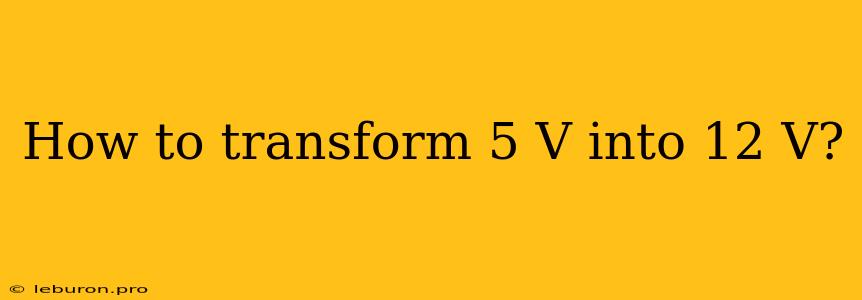Transforming a 5V power supply into a 12V one is a common requirement in electronics projects. Whether you're powering a device that requires a higher voltage or simply need to adapt to different power sources, understanding the methods and components involved is crucial. This article will guide you through various techniques for converting 5V to 12V, exploring the advantages and drawbacks of each approach.
Understanding the Basics: Voltage Transformation
Voltage transformation refers to the process of converting a voltage level from one value to another. This can be achieved through various methods, each with its own principles and applications. In our case, we want to increase the voltage from 5V to 12V, which is known as voltage step-up. This process involves using electronic circuits or devices to boost the voltage level.
Boost Converters: The Go-To Solution
Boost converters, also known as step-up converters, are the most common and efficient method for transforming 5V into 12V. These DC-DC converters utilize a combination of inductors, capacitors, and a switching element (usually a MOSFET) to achieve voltage conversion.
How Boost Converters Work
- Charging the Inductor: The inductor is initially connected to the 5V input source, allowing it to store energy in its magnetic field.
- Switching: The switching element rapidly turns on and off, disconnecting the inductor from the input and connecting it to the output.
- Inductor Discharge: As the inductor discharges its stored energy, it generates a voltage that is higher than the input voltage.
- Capacitor Smoothing: The output voltage is then passed through a capacitor to smooth out any voltage fluctuations, providing a stable 12V output.
Advantages of Boost Converters:
- High Efficiency: Boost converters can achieve high efficiency levels, often exceeding 90%.
- Adjustable Output Voltage: Many boost converters offer adjustable output voltage settings, allowing you to fine-tune the output voltage for specific applications.
- Compact Size: Modern boost converters are available in small form factors, making them suitable for compact electronic projects.
Disadvantages of Boost Converters:
- Ripple Current: The switching action of the converter can introduce ripple current into the output, which may be undesirable in sensitive applications.
- Cost: While relatively inexpensive, boost converters can be more costly than other methods.
Other Methods for 5V to 12V Transformation:
While boost converters are the most widely used method, there are other options for transforming 5V to 12V, although they may have limitations or be less suitable for certain applications.
Voltage Multiplier:
A voltage multiplier is a circuit that uses capacitors and diodes to step up the voltage. It effectively creates a series of voltage "stages" where each stage adds a portion of the input voltage to the previous one.
Advantages of Voltage Multipliers:
- Simple Design: Voltage multipliers can be built using a small number of components.
- Low Cost: They are generally inexpensive to build.
Disadvantages of Voltage Multipliers:
- Low Efficiency: Voltage multipliers have relatively low efficiency compared to boost converters.
- Limited Output Current: They typically cannot deliver high output currents.
- Voltage Ripple: Output voltage can have significant ripple, requiring further filtering.
Transformer-Based Solution:
A transformer can be used to transform 5V AC into 12V AC. However, this approach requires an AC source and a transformer with the appropriate turns ratio.
Advantages of Transformers:
- High Power Handling: Transformers are capable of handling high power levels.
- Isolation: Transformers provide electrical isolation between the input and output, which can be beneficial for safety reasons.
Disadvantages of Transformers:
- Bulky: Transformers are generally larger and heavier than other methods.
- AC Requirement: They require an AC source to function.
Considerations for Choosing the Best Method:
The most suitable method for transforming 5V to 12V depends on several factors:
- Output Power: The amount of power required from the 12V output.
- Efficiency: The desired level of energy efficiency.
- Size and Cost: The available space and budget for the conversion circuit.
- Output Ripple: The tolerance for voltage fluctuations in the output.
Conclusion:
Transforming 5V into 12V is a common task in electronics projects, and understanding the various methods available is essential for selecting the most appropriate solution. Boost converters stand out as the preferred choice for their efficiency, versatility, and compact size. However, voltage multipliers offer a simple and low-cost alternative, while transformer-based solutions can handle high power levels and provide isolation. The best approach will depend on your specific project requirements and limitations. Remember to carefully consider the factors discussed above to ensure you choose the most suitable method for your needs.
